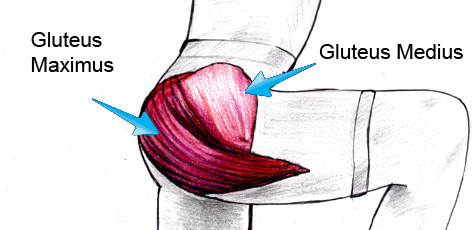
How To Strengthen Your Weak Gluteal Muscles
By Sherwin Nicholson | Updated May 1, 2020
Your glutes are your most important muscles to exercise in your entire body
They are important because they keep all of your body stable and protected (yes, those are your butt muscles!)
They consist of the minimus, medius and maximus. Of the three, the maximus is the largest. The gluteus maximus gives you the necessary power to push or to propel your body upward or forward. You need to keep this muscle healthy and active. It’s what virtually all true athletes rely on and train tirelessly to achieve their goals. As non-athletes we need them to keep our spines stable and pain free.
It is as vital for performing a triple jump in track and field, to simply getting out of bed without hurting.
When your glutes stop providing the power you need to raise the lower body, then the quadriceps must compensate (and that is NOT a good thing).
Never let them be over shadowed by your quads. You’ll end up with knee problems. In fact, people spend a lot of time failing to fix their knee pain because they are not aware that the muscles they sit which are the problem.
Weak glutes also result in tight hips, a lack of much needed hip flexibility and of course hip pain. The more than you can prevent this from happening, the easier it will be for you to release both hip and lower back tension and discomfort.
If you sit on them, you’ll lose them
Unfortunately, this group is the most neglected of all of the skeletal muscles. Unless you are an athlete, you rarely think about them. Most of us do not compete in track and field every day, but we all sit for extended periods of time. This is the very group of muscles that MUST stop functioning when we sit. In fact, we reduce the flow of blood to this group as well when seated which quickly adds to the problem of weakening.
Chances are right now that you are on this site because you have weak gluteal muscle issues. You are most likely doing the very thing that causes them to become impaired. Sitting all day at work.
Sitting may be unavoidable at times, but let’s understand more of what it does. Sitting also reduces the activity of the nerves that are involved in stimulating and contracting them. It is very significant and detrimental to the healthy functioning of the glutes.
Dilemma? Choosing between lifestyle versus discomfort
Does this mean that we must choose between sitting for extended periods of time or healthy glutes to relieve lower back and muscle pain?
The answer is not so simple.
Many sources of information that you will come across to answer this question will explain to you that the answer is simply to feel guilty about your sedentary career or lifestyle and to immediately rush to a gym and incorporate numerous complex, very challenging and perhaps difficult glute activating reps.
This does work for some. Some of us can and will succeed at this. But for the rest of us, it will take either more convincing or a different approach to truly address this problem.
Weak glutes = Back pain
The average person with this common weakness also has lower back pain. They are linked. Your lower back depends on your hip flexors, glutes and hamstring conditioning to remain balanced and safe.
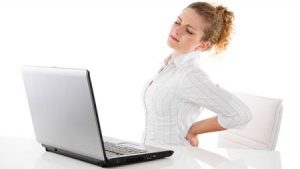
Rushing to the gym or quitting your desk job is NOT always an appropriate option. If you already have discomfort, you are less likely to exercise.
To begin to answer this question, you will need to become more aware of what skeletal muscle group you are affecting and at what time. This does not mean that you will need to take a class in physiology or kinesiology.
For the time being, understand that sitting is an immediate compromise to your butt muscles. When they are compromised, then what they do and what they protect also are. This may make one feel guilty, but it’s the type of guilt that leads to compelled action. You will no longer want to continue to treat them the same way.
Most treatments are boring and easily ignored
There is a dilemma for a treatment of this problem of weak glutes. Most methods of treatment are the same regardless of whether they are recommended by you family doctor, physiotherapist, personal trainer or from the internet.
These methods are the same because the gluteals require a particular exercise movement. Even though there are some variations to them, essentially it is based on the same movement. This may seem unappealing to some so it is easily disregarded and forgotten and may cause more discomfort with a reluctance for treatment.
A better way to help yourself instead
The best solution is to do the exercises as part of your daily regiment so that it doesn’t feel like extra work. This way you can kill two birds with one stone. The advantage is that it becomes more natural to do and eventually becomes an important way to keep these muscles conditioned to prevent or minimize injury. You also don’t forget to do them because you doing it naturally.
Lunges are necessary for pain relief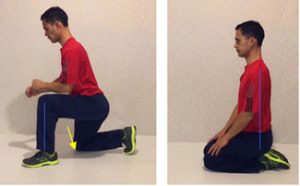
One very important way to strengthen your glutes is by performing the lunge. Lunging both strengthens and maintains them. It’s one of the most recommended movements by practitioners because it is necessary.
You simply cannot improve your muscle function without it. All athletes perform them because it gives them their edge for winning.
For the rest of us however, no one really wants to perform them due to time and the difficulty level that this movement requires. Another problem is that if you’re already sore, lunging makes you feel unbalanced (because 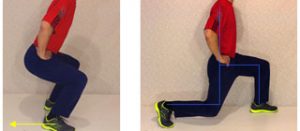 your muscle weakness) and you become reluctant to do them at all.
your muscle weakness) and you become reluctant to do them at all.
Don’t give up on them. It’s a learning process.
But the average person with glute challenges and lower back pain can carry out this exercise without having to invest a lot of time.
To see how this exercise can be performed with little time invested, please go to the Weak Gluteal Muscles Page.
Start the simple way
If you prefer an easier method in which to begin to strengthen your glute muscles, then go to the One Simple Rule 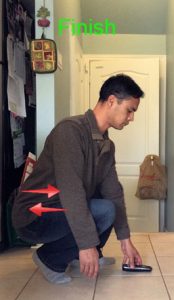 (How to Protect Your Back) page before trying any lunges. This is actually an easy technique that you can use frequently.
(How to Protect Your Back) page before trying any lunges. This is actually an easy technique that you can use frequently.
As you do the lunge, you’ll notice how much it will help treat both your glutes and reduce your pain. Carry out this exercise whenever you need to lower your body and also to avoid leaning forward. Do not give yourself the option of leaning forward to prevent lumbar disc injury.
It can become a no brainer in no time
In the course of a single day, you can perform this exercise dozens of times with no extra time invested. After one week or two, you will have performed it hundreds of times with little risk to your lower back.
Within a month, you should notice a big difference in your legs and lower back with a significant reduction in pain.
For more help:
Do this for your weak sitting muscles
How to test yourself for weak glutes and back pain
The most effective self help guide for glute, hip and back pain
References:
All references can be found on the Sitewide page
